Sphalerite Gemstone: Properties, Meanings, Value & Uses
 Sphalerite gemstone is a zinc sulfide stone that comes in many colors but usually autumn shades of orange, brown, and yellow. Is sphalerite a gemstone? Yes! While more common for non-gemstone uses, gem-quality sphalerite can have similar transparency and fire to diamonds.
Sphalerite gemstone is a zinc sulfide stone that comes in many colors but usually autumn shades of orange, brown, and yellow. Is sphalerite a gemstone? Yes! While more common for non-gemstone uses, gem-quality sphalerite can have similar transparency and fire to diamonds.
Is sphalerite rare or common? As a mineral, sphalerite is very common — one of the most common sulfide minerals, actually. However, good-quality, facetable sphalerite is rare and exotic among gemstones.
In this article, you’ll find everything you need to know about the sphalerite gemstone, from its mineral and healing properties to its value and sources.
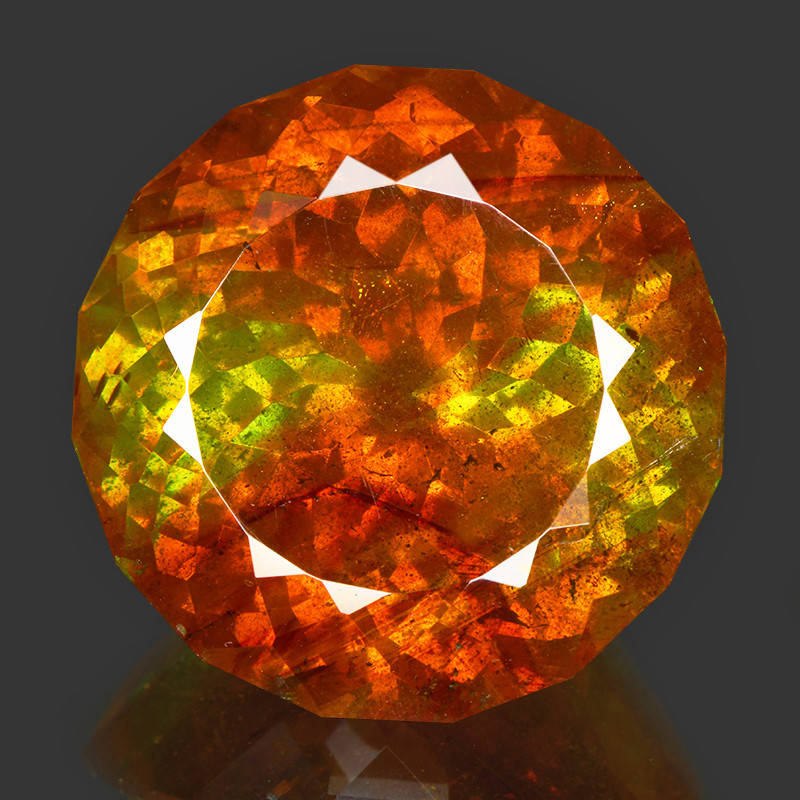
About Sphalerite Stone
The sphalerite mineral, or “zinc blende,” is most widely known as an important source of zinc. In fact, roughly 95 percent of the world’s zinc comes from sphalerite!
As a semi-precious gemstone, sphalerite is beloved for its color range and high dispersion. Dispersion is a type of light reflection where white light splits into multiple colors, creating a multi-colored sparkle. Most gem enthusiasts associate impressive dispersion with diamonds, but sphalerite’s dispersion is three times higher!
Astrologically, sphalerite is a zodiac stone for Gemini. Red sphalerite can also be an affordable alternative to ruby, the traditional July birthstone.

Sphalerite Specifications & Characteristics
“Sphalerite” can describe a group of minerals or one mineral in that group. So, what is sphalerite made of? It varies.
The main sphalerite formula is zinc, iron, and sulfide, with an iron content usually under 25 percent but sometimes as high as 40 percent. Different iron amounts can change sphalerite’s color, transparency, fluorescence, and refractive index.
Impurities are always present, often cadmium, mercury, and manganese. You may see gallium, indium, and germanium impurities as well, along with others. Trace elements or minerals often determine sphalerite’s color.
Twinning is common in sphalerite’s structure. Sphalerite pseudomorphs may also have the crystal structure of similar minerals like calcite or galena.
You can identify sphalerite by its six-sided perfect cleavage, luster, and streak. “Streak” refers to the color of a mineral’s powder after scraping it across a streak plate like unglazed porcelain.
Sphalerite’s streak is usually white, reddish-brown, or yellow and smells like sulfur. Sphalerite luster often changes alongside its transparency. Transparent gems are adamantine, while translucent or opaque gems are dull to resinous.
You’ll find all of sphalerite’s properties below:
Mineral family: Sphalerite group
Composition: Zinc sulfide; (Zn, Fe) S
Mohs hardness: 3.5-4
Color: Usually shades of brown, yellow, or black; Can be red, gray-blue, green, red-orange, purple, or colorless
Crystal structure: Cubic/Isometric
Luster: Dull, resinous, or adamantine
Transparency: Translucent to transparent; Opaque with high iron content
Refractive index: 2.37-2.50
Density: 3.90-4.20
Cleavage: Perfect dodecahedral (six planes) on [011]
Fracture: Uneven to conchoidal
Streak: Brownish-white, light yellow, white, or reddish-brown; Occasional sulfur odor during streak test
Luminescence: Often fluorescent in bright orange-red to red; Sometimes triboluminescent (glows under friction)

Types of Sphalerite
There are many trade names for different sphalerite varieties. Let’s break them down:
Black-Jack: Nickname for opaque, dark-colored stones
Cleiophane: Franklin, New Jersey’s transparent, colorless to light green variety with strong orange and blue fluorescence
Golden Sphalerite: Yellow to orange variety
Marmatite/Christophite: Opaque, black variety from Colombia’s Marmato mines or Germany’s St. Christoph mine
Ruby Blende/Ruby Zinc: Trade name for brownish-red, red, or orange sphalerites
Rosin Jack: Yellow or amber-colored variety; Also called rosin zinc, rosin blende, or resin jack
You know the mineral properties, but what are the metaphysical properties of sphalerite? Let’s start with its spiritual meaning.

Sphalerite Meaning & History
Sphalerite symbolizes bravery, vigor, and spark. In terms of elements, sphalerite is both a fire and earth stone.
As a fire and earth stone, sphalerite embodies the “feet on the ground, head in the clouds” idea. This crystal stimulates energy and imagination while keeping you grounded and preventing burnout. This duality and balance is another reason sphalerite is perfect for Geminis!
German mineralogist Ernst Friedrich Glocker made the first official discovery of sphalerite in 1847. Glocker chose the name after the Greek word sphaleros, meaning “deceitful” or “misleading,” since the mineral looked like galena (a valuable lead source) but didn’t contain lead. Plus, sphalerite resembled many other stones, making it hard to identify.
Before Glocker, the mineral went by names like “zincum” or “blende.” German mineralogist Georgius Agricola chose the name “blende” in 1546, and miners mostly used this name until Glocker came along.
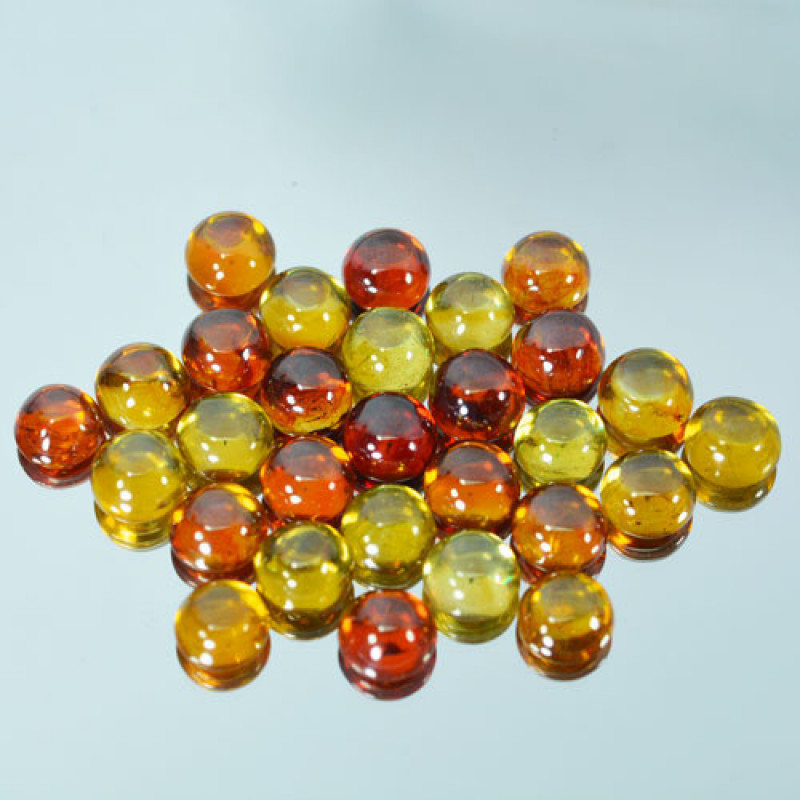
Non-Gemstone Uses
Sphalerite’s uses as an ore date back as far as 7th-century AD. Analysis of brass items from Medieval times shows that Islamic folks in this era used sphalerite to make brass. Plus, some evidence suggests sphalerite might have been a tool for cementing brass in 12th- to 13th-century China.
Nowadays, how is sphalerite used in everyday life?
Zinc obtained from sphalerite is essential for creating metals like brass or bronze and coating steel and iron (galvanized metal) to prevent corrosion. Sphalerite is also used for transmission towers (which support power lines), cars, and batteries.
Zinc is also important medicinally. The element can help our immune system fight viruses and protect our skin from the sun’s harmful UV rays.
Besides zinc, other element impurities common in sphalerite are useful for technology. One is indium, which is used in cell phone screens. Another is germanium, which is used in cell phone batteries, circuitry, vibration parts, and LED displays.
We’ve covered the industrial uses, but what is sphalerite used for in healing?
Sphalerite Healing Properties
The colors and vibrations of gemstones can make them powerful healing crystals. With the stone’s diverse color range, sphalerite metaphysical properties are abundant.
Many sphalerites are brown, joining other brown gemstones in promoting safety, comfort, and connection with Mother Earth. Yellow gemstones like golden sphalerite impart joy and concentration.
Can sphalerite be purple? It’s rare, but yes. What does purple sphalerite do? Like all purple gemstones, these crystals enhance wisdom and spiritual awareness.
Let’s look at how to use sphalerite for physical, emotional, and chakra healing!
Physical Healing
Physical benefits of sphalerite may include aiding the immune system and nervous system. Sphalerite is often used for increasing energy and strength, especially after intense exertion.
Crystal healers believe sphalerite can heal eye disorders, balance blood oxygen levels, and improve the immune system.
Emotional Healing
Emotionally, sphalerite provides grounding and balancing energy. The stone is said to increase confidence and inspire creativity.
A sphalerite crystal may help you express yourself more clearly, adjust to transitions, and recover from difficult situations more easily.
Chakra Healing
Healing your chakras is an ancient practice where you identify symptoms associated with a specific chakra (or energy center). Then, you balance the chakra to resolve those symptoms, often with a chakra stone.
What chakra is sphalerite? Sphalerite chakra healing is best for the root chakra, which governs basic needs for stability and connection.
Feeling lost, paranoid, or isolated are signs of a blocked root chakra. You can use sphalerite to open the chakra, allowing you to feel strong, safe, and protected.
Sphalerite Gemstone Properties
Gem experts judge a stone’s objective value based on factors called gemstone properties. Sphalerite’s value relies on cut, color, and clarity, followed by carat weight.

Color
The most common sphalerite colors are reddish-brown, dark brown, black, yellow, and orange. Green, red, purple, gray-blue, and white sphalerite varieties are rarer.
Generally, orange or red sphalerite gems command the highest prices, while brown, green, and yellow-green specimens have lower value. Lighter-hued stones usually have better dispersion, creating higher value.
Yellow hues are often caused by calcium, copper, mercury, cerium, and germanium impurities. Tin, molybdenum, and silver usually create red sphalerite, while iron and cobalt make green ones.
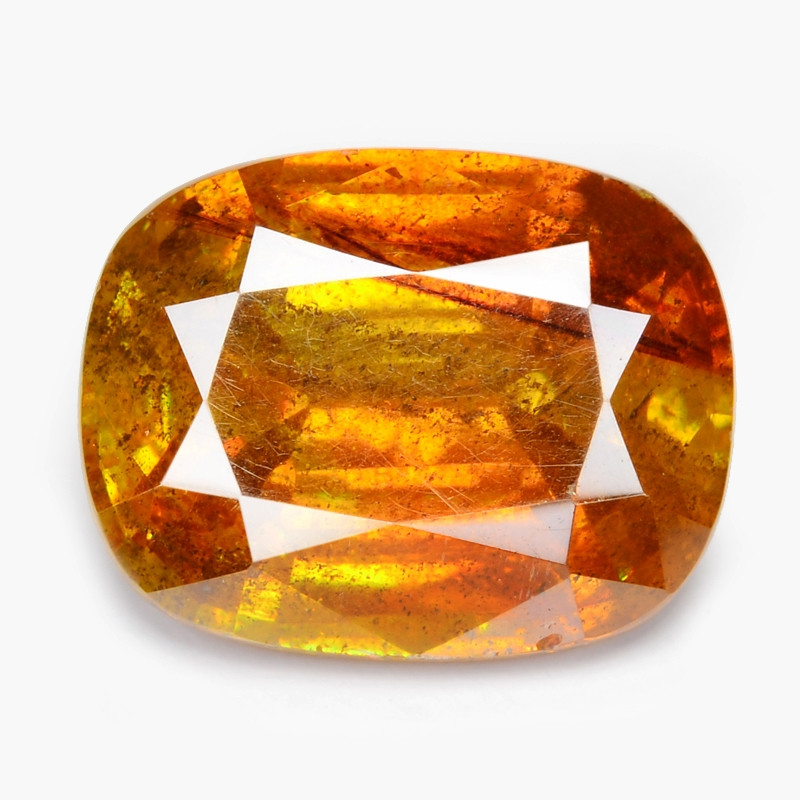
Cut
Sphalerite gem hardness ranks quite low. Combined with its brittleness and perfect cleavage, sphalerite is a difficult gem to cut. Therefore, it’s more common as a raw, collector’s specimen.
Expert gem cutters who attempt it usually pick faceted cuts for displaying brilliance, like trillions, rounds, and cushions.
Occasionally, sphalerite combines with wurtzite, a mineral with the same composition but a different crystal structure. The two stones layer to become schalenblende, which is sometimes cut as cabochons.

Clarity
Clarity measures inclusions in a gemstone. Sphalerite is Type III on the colored gemstone clarity scale, meaning you can almost always see it with inclusions with the naked eye. Only small sphalerites can look inclusion-free.
Sphalerite’s signature dispersion is more obvious in less-included specimens, so the rare stones with decent clarity command higher prices.
Carat Weight
Any sphalerite gem above three carats is highly valued, particularly orange and red ones. Any color of small sphalerites isn’t as valuable.
Sphalerite rough can be huge. For instance, Spain produces massive rough facetable stones, up to 100 carats. Mexico also produces fine sphalerite material that’s been faceted into 50-carat stones.
Synthetics
Synthetic sphalerite is common for scientific research and gemstone purposes like decor and jewelry. Because of natural sphalerite’s fragility, synthetic ones offer more diversity in sphalerite jewelry options.
Looking at natural sphalerite, how does it form?
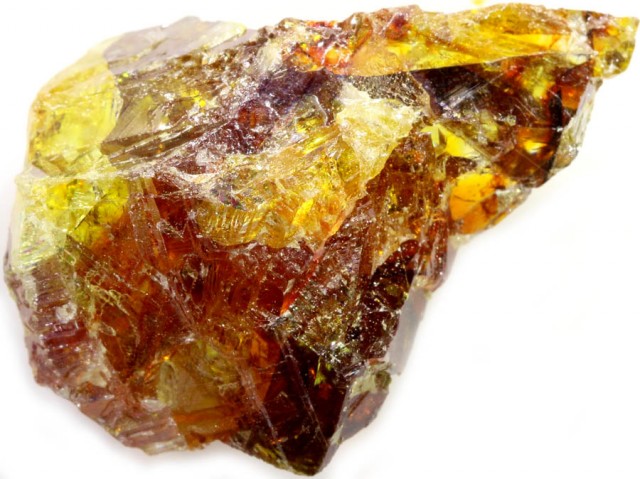
Sphalerite Formation & Sources
Sphalerite can form through many different processes. The most common types of deposits for finding sphalerite are:
sedimentary zinc-lead (SedEx) deposits,
volcanic-hosted massive sulfide (VHMS) deposits, and
carbonate-hosted lead-zinc ore deposits.
SedEx and VHMS deposits are underwater. The SedEx deposits form at seafloor vents; the VHMS deposits, from underwater volcanic rocks.
Sometimes, sphalerite forms when hot groundwater or magma alters carbonate rocks, introducing zinc-rich fluids.
The melted solution slips into rock cavities or replaces portions of the carbonate rock (its “host rock”), then hardens into sphalerite. The process of replacing carbonate rock portions is common in lead-zinc deposits, or “Mississippi-Valley-type” (MVT) deposits.
Different environments and conditions can alter sphalerite’s composition. For example, higher temperatures usually lead to higher iron content (if there’s iron available in the deposit).
Once it forms, regardless of the process, where is sphalerite found?
Mining Locations
Dozens of countries produce sphalerite. Spain is perhaps the best-known producer, mining large, high-quality crystals of transparent, red-orange to toffee-brown sphalerite.
The other current top producers for gem-quality sphalerite are:
Australia
Bolivia
Canada
China
Czech Republic
Democratic Republic of Congo
England
India
Ireland
Kazakhstan
Mexico
Peru
Romania
Scotland
Sweden
USA (predominantly Mississippi River valley region)
Next, how much is sphalerite worth?
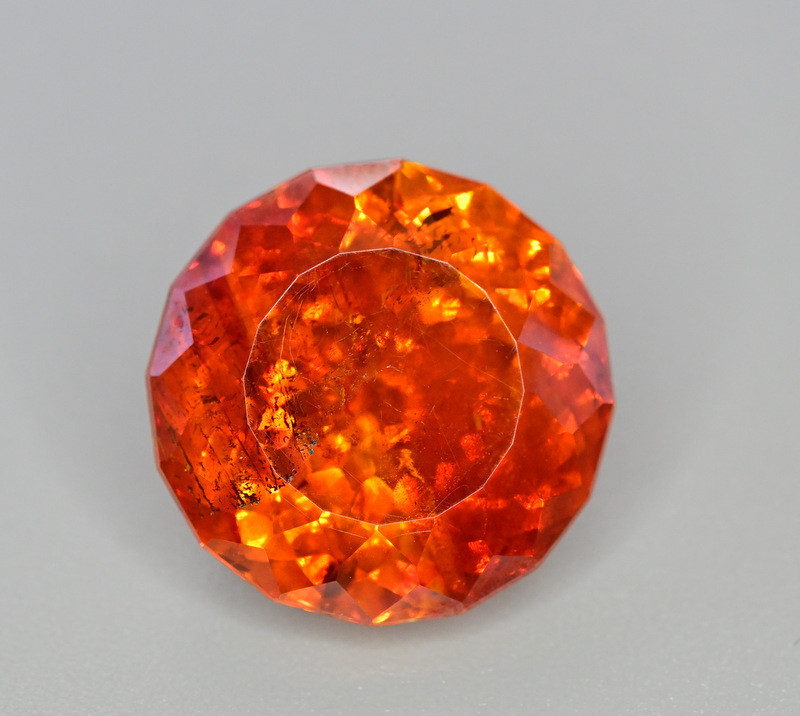
Sphalerite Price & Value
First things first, is sphalerite expensive? Sphalerite gemstones can be pricey, but it depends on quality factors. Overall, the sphalerite gem price ranges from $20-$200 per carat.
The highest-value stones are transparent, relatively inclusion-free, above three carats, and medium reddish-orange. These high-quality gems can be up to $200 per carat but are usually around $70-$100 per carat.
However, the expertise needed to facet sphalerite means all faceted sphalerites command higher prices than rough or unfaceted ones. A one-carat, dark reddish-brown faceted sphalerite averages around $65 per carat. Medium yellow or orange-yellow, one-carat gems are between $90-$100 per carat.
Sphalerite cabochons at wholesale prices range from $15-$50 per carat. By far, the most affordable is sphalerite rough, at $0.40-$1.50 per carat.
Given sphalerite’s steep prices, you’ll want to make sure your gem lasts.

Sphalerite Care and Maintenance
Caring for gemstones keeps them looking beautiful and ensures they last as long as possible. Sphalerite’s 3.5-4 hardness ranking means even household dust (at 7 hardness) can scratch it. Therefore, we recommend sphalerite pendants or brooches over a sphalerite ring.
To clean sphalerite safely, use a soft toothbrush, mild soap, and lukewarm water. Rinse all the soap residue from the stone, then let it air dry.
To prevent damage, avoid exposing your sphalerite to high temperatures and household chemicals (like cleaning products, hairspray, perfume, etc.).
Take off your sphalerite jewelry before doing any intense physical activity. Store the gem wrapped in a soft cloth in a fabric-lined container away from other gemstones.
Spellbound by Sphalerite Gemstones?
Sphalerite is a valuable gem in so many ways — for industrial uses, crystal healing, and of course, beautiful jewelry. Any gemstone collector or enthusiast needs to have one of these colorful, sparkling stones in their collection!
Shop sphalerite gemstones for sale today!
Was this article helpful?
Ross Sedawie
- Written - 12th Mar 2022
- Edited - 1st Aug 2023

















